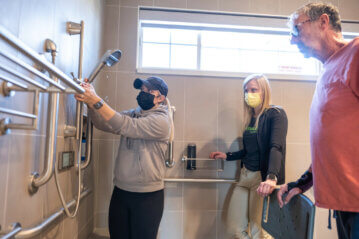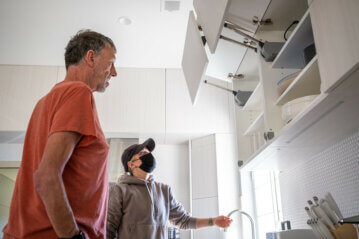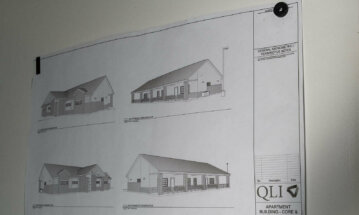Thirty years in the future. That marker is simultaneously a long and short time. What will we as individuals look like then? What will be the norms? How will we as people, as a society, change in the interim? Such was the question QLI asked for its thirtieth anniversary in 2020–thirty years removed from the establishment of QLI in 1990. Three decades brought tremendous growth, and the course of injury rehabilitation was on an exciting path. But what would this all look like in thirty more years? QLI’s leadership team plotted out visions–not just what they thought would be possible, but also what the ideal would look like. One of the visions was a community-living center with dozens of technologically accessible apartments and living spaces.
QLI, never an organization to sit idly by and wait for the change to happen, set in motion a plan to trial these visions. From this came the creation of QLI’s Smart Apartment pilot program. Occupying space just beside the Lied Life Center, the Smart Apartments act as a way to not only demonstrate what present technologies are fully capable of in a home environment, but whether the vision could be realistic and sustainable.
Often, notes QLI Chief Technology Officer Scott Meyers, such development crucially begins with in-person interaction, starting with fostering relationships with community partners and industry leaders. Holland Basham, an architectural firm, was on board from the word “go.” From there it was a matter of drawing up a thorough plan of attack.
The building housing QLI’s smart apartments includes two units, designed to provide a transitional, accessible home for those who have graduated from QLI’s inpatient rehabilitation. Some of the technology in the apartments, notes Scott, is multi-modal, meaning it can be accessed physically in a “normal manner” while also being adapted to work with motion or voice controls. For example, with prompting, the kitchen sink can dispense exactly one cup of water, and then shut off. Likewise, applications such as Amazon’s Alexa and Control4 allow for full light control and other environmental controls.
The entire design of the smart apartments is meant to bring an environment to the individual. A traditional coat closet, for instance, would be inaccessible to an individual in a wheelchair. With a button pressed, the coat racks in the apartments come out and lower to an accessible height. The oven has
Such a notification also protects the dignity of a resident in a vulnerable state. If a person falls while using the shower, the camera will display to the on-call individual an infrared image. Likewise, there are robot controls, one named “Rosy,” that let a person zoom in to talk with their family members, or a clinician can initiate a session, and the robot will follow the client around the apartment.
Naturally, these apartments are still in a trial phase—with the priority being to gauge client feedback and determine if such accommodations are viable for a future community with dozens of such accessible and 
Categories: Adaptive Technology, Assistive Technology, Reimagined Tech, Smart Apartments

